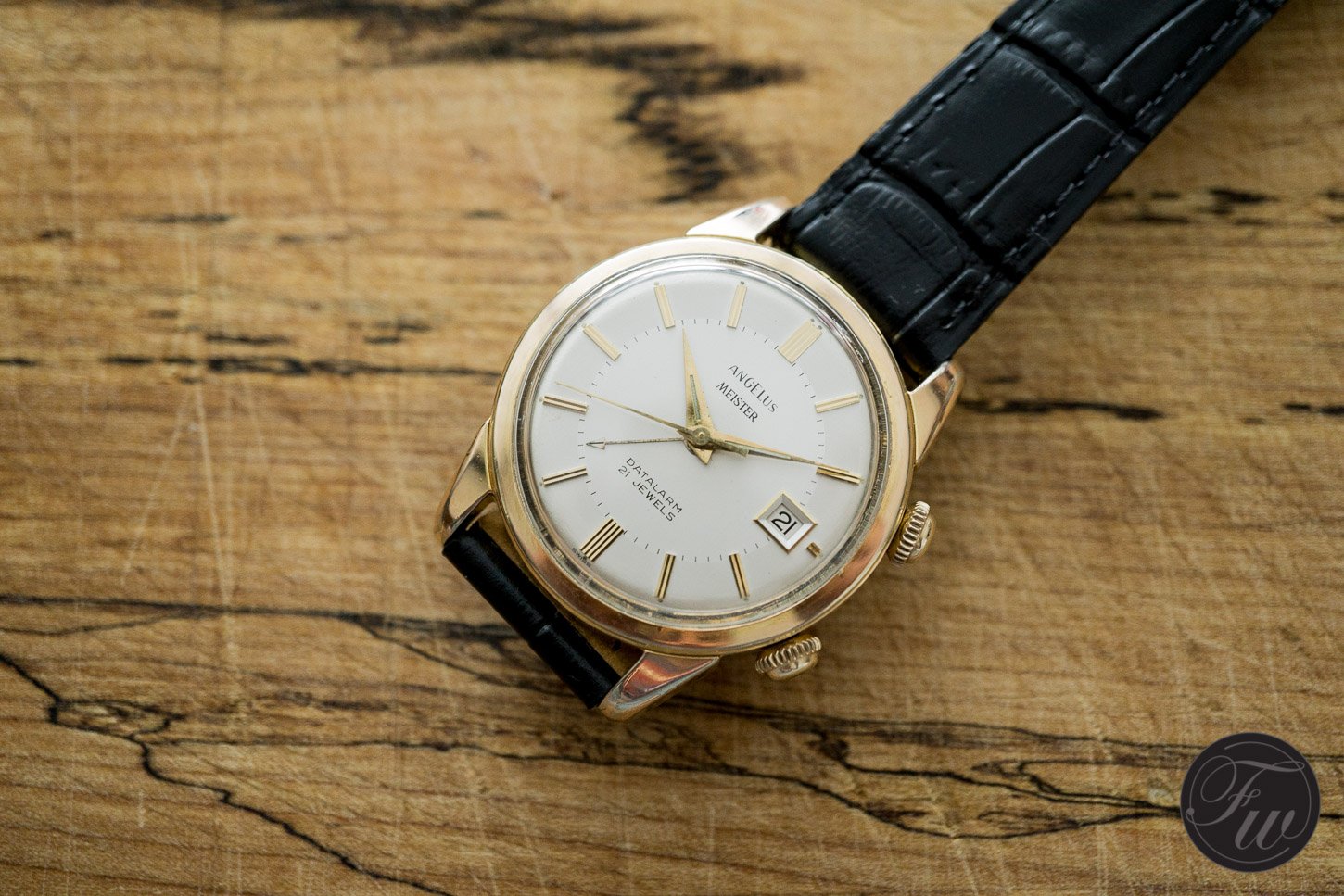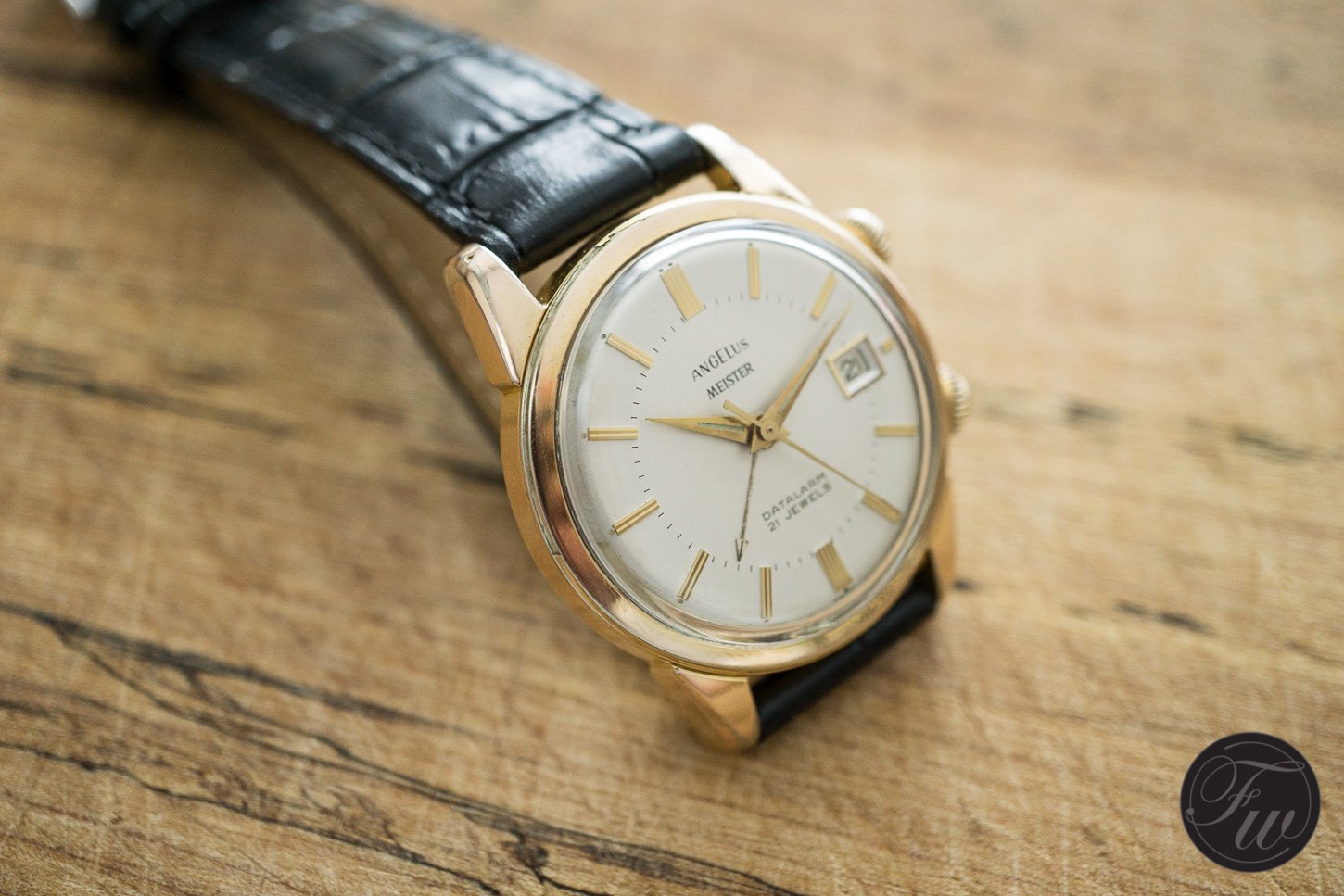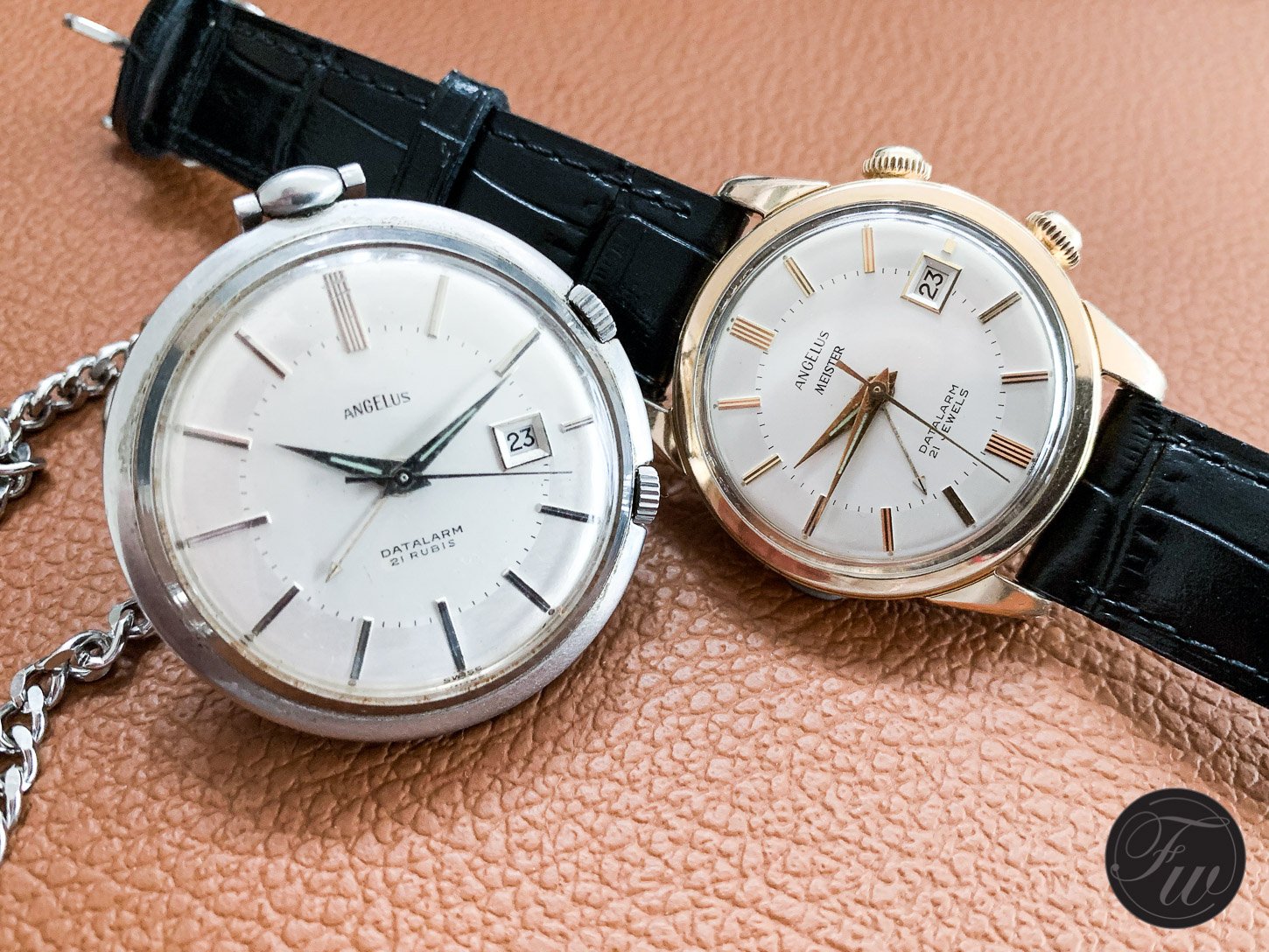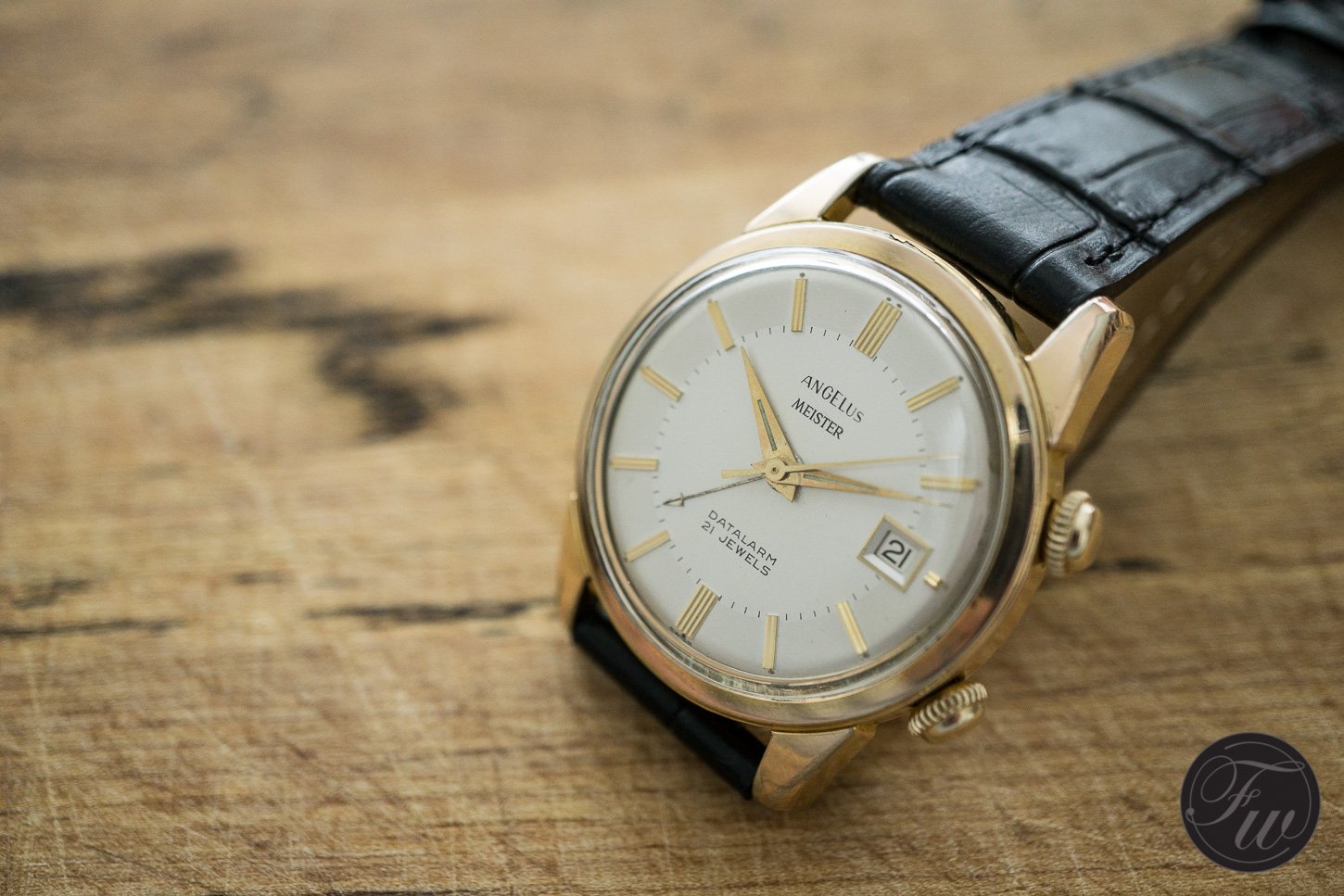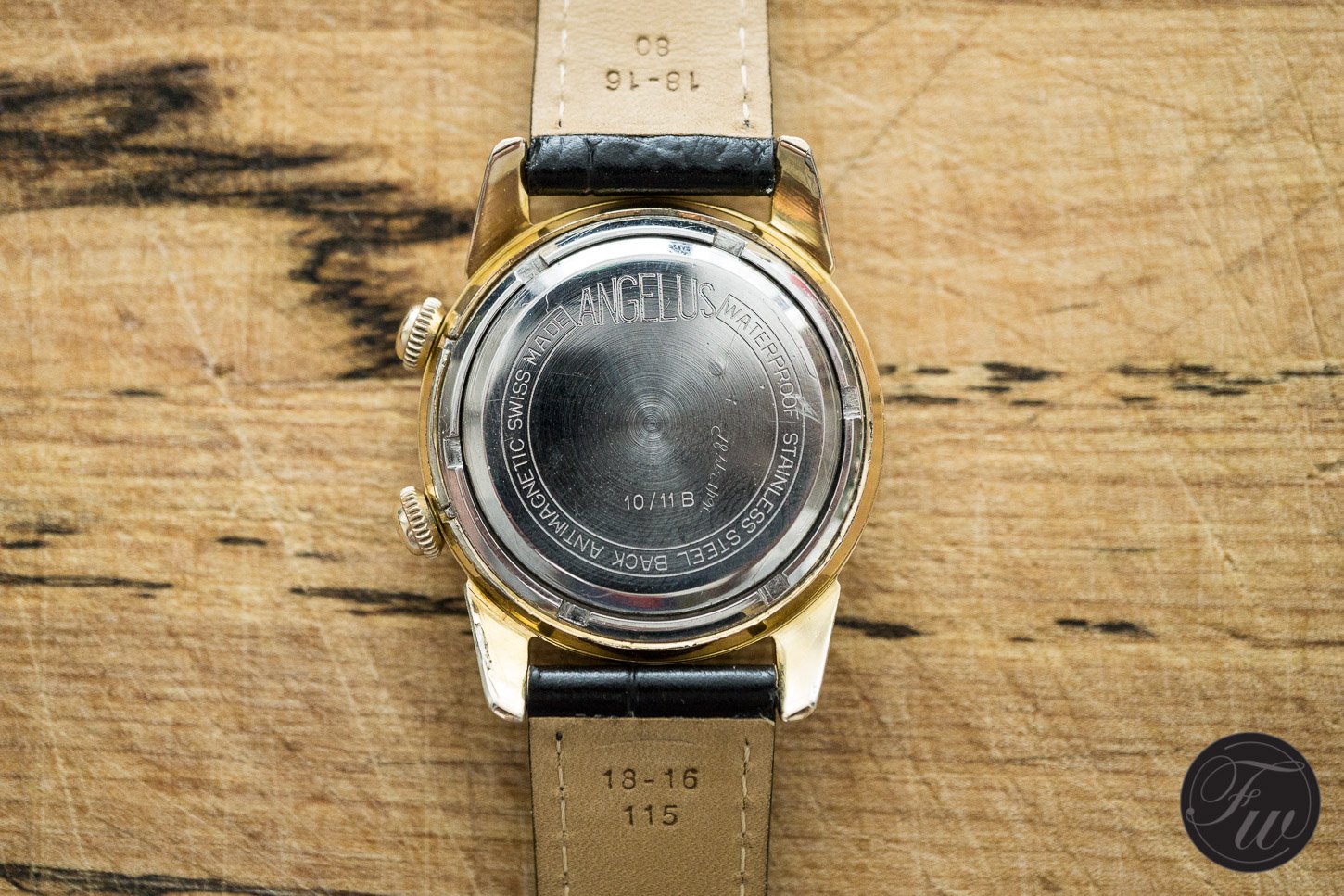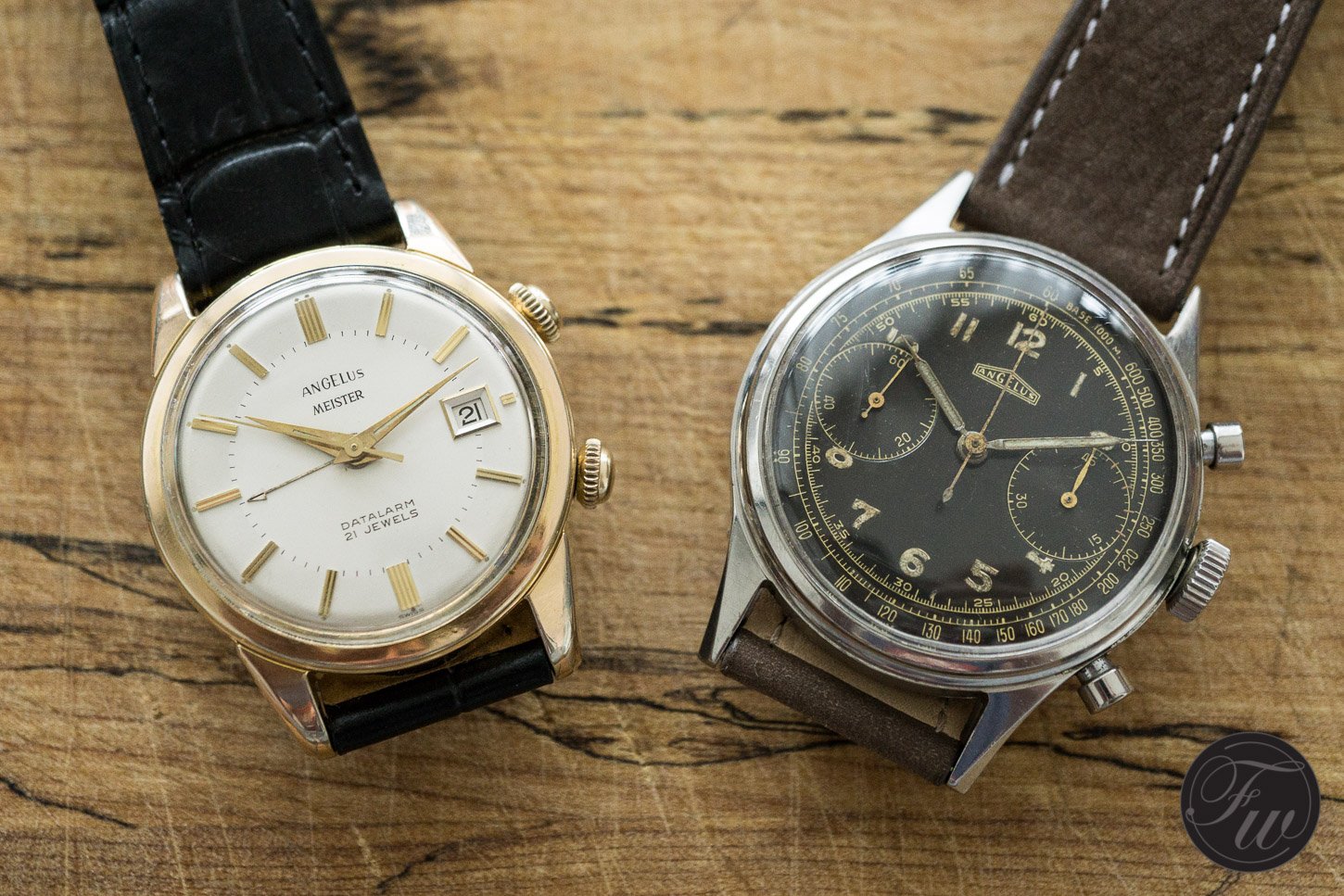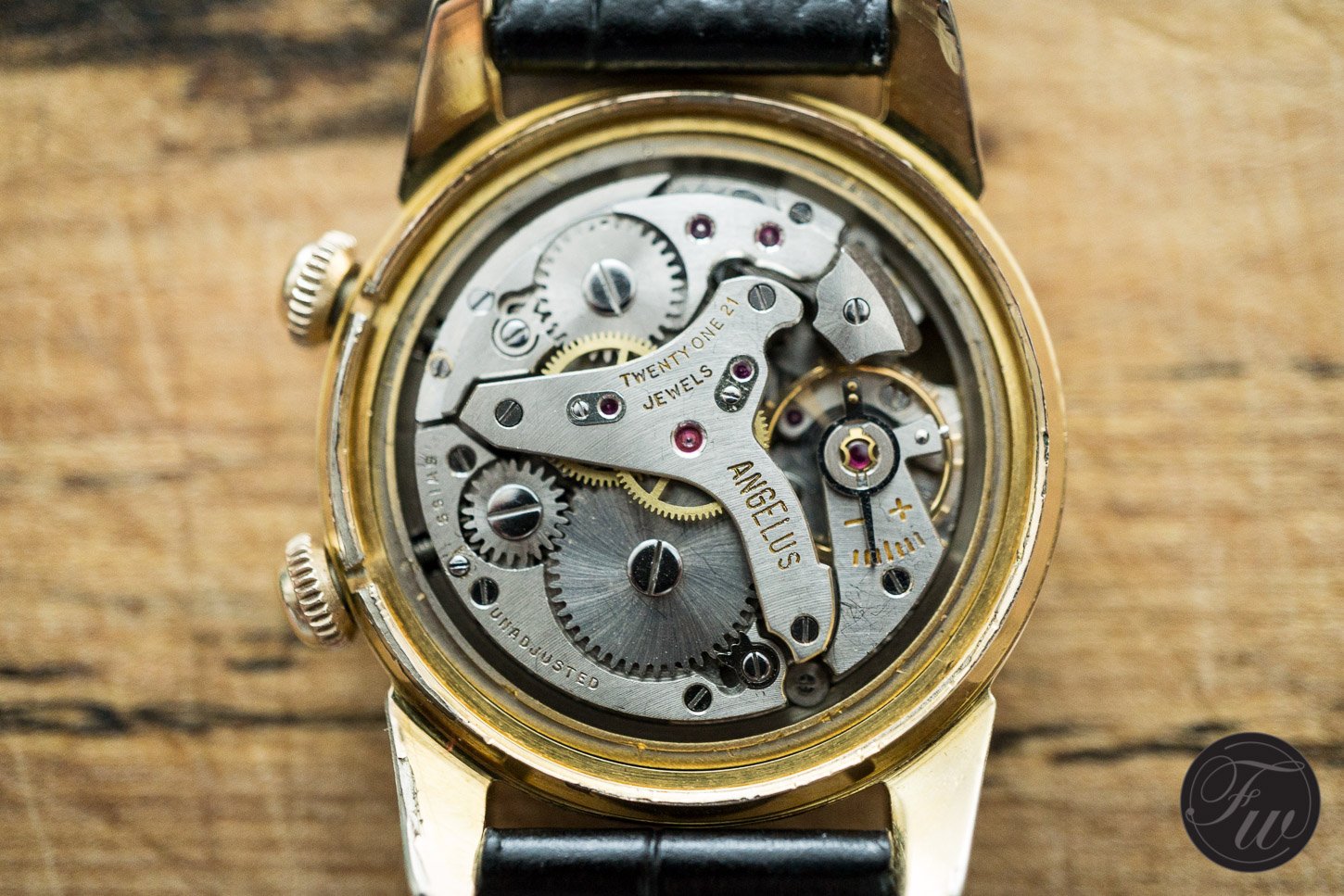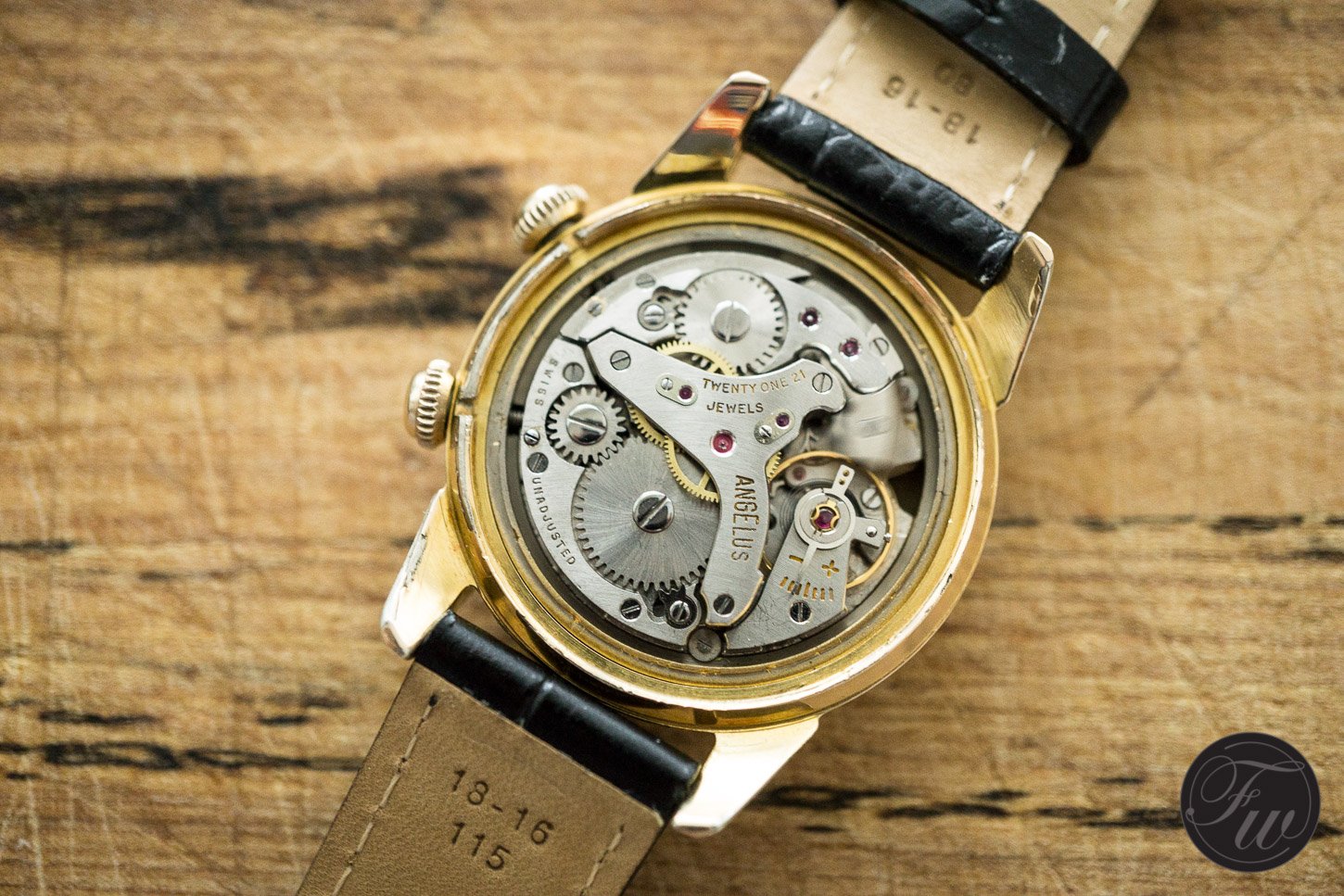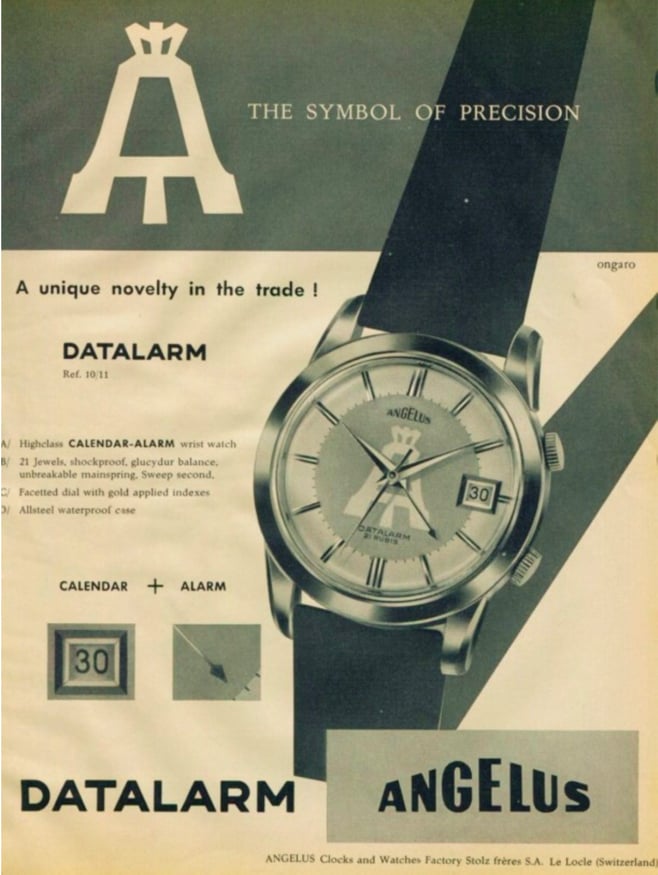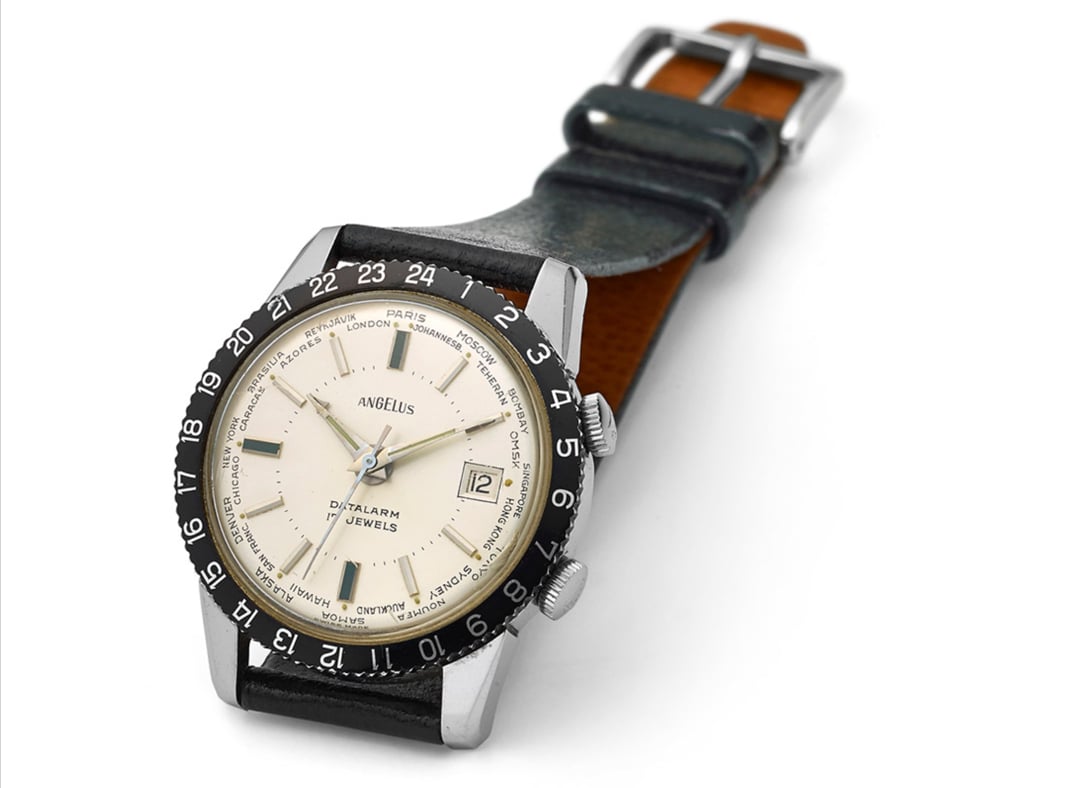A Closer Look At The Angelus Datalarm
If you had to choose one watch complication that you cannot live without what would that be? Many would probably say; it has to be a chronograph.
But how often do we time anything with them anymore? Not too often, I guess. Others might say; it needs to have a date. Yet, we can find out what day it is these days pretty easily. Still, complications, whether they are as simple as a date or complex like a perpetual calendar, influence our decision when buying a watch. More often than not, they are the single most important thing to consider when making a purchase decision; I wanted a flyback chronograph, so I bought XYZ watch. This was more or less my thought process when I went for the Angelus Datalarm. Aside from that, it is an awesome watch and under the radar. It has a bunch of cool other features too.
The Angelus Datalarm
Alarm
I wanted a watch with an alarm function ever since I heard my friend Eric Wind talking so fondly about his vintage Vulcain Crickets. Not necessarily for the alarm function, for that, I have the good old iPhone. More so for the sheer pleasure of owning a watch that is capable of doing such a thing. To me, a mechanical alarm is the complication of those huge old tin alarm clocks. It always fascinated me how can they implement this type of movement in a much smaller case. Now, of course, I understand that it is not such a big deal. Still, my captivation for alarm watches remained. As a matter of fact, one of my first vintage Omegas was a Memomatic with the rare blue and silver dial. During my Angelus research, I learned that they indeed had an alarm watch, the Datalarm.
Datalarm
So, the hunt was on. I wanted to find an Angelus Datalarm with a decent to nice dial (rather hard) and a functioning alarm. Albeit the case back on these is screw-in due to the fact that it has 2 crown tubes the possibility of getting water in the case through either of those was high. Especially since the alarm only works if the crown (at the 2 o’clock) that sets the alarm is out. Angelus created the Datalarm around the end of the 1950s (1957/58) however it had quite a long run. Many different case versions saw the light of day, both in steel and gold plated. Different case shapes were used such as round (like mine under the reference 10/11 B) or cushion (16/11 B). Angelus even created a pocket watch Datalarm (11/11 B) also in steel and gold plated. The B refers to later generations.
Case
I saw some pocket watches that someone converted into wristwatches. You can tell this by the remainder of the hinge on the case at 12. Luckily most of the watches you can find on the market are the real deal though. The case is not large at all at 34.8mm. The thickness, however, is pretty substantial for a watch like that at 12.2mm. The lug tip to lug tip length is also a nice 42mm. With these measurements in mind and knowing that the bezel, as well as the lugs, are rather thick, the Angelus Datalarm wears actually well even on a larger size wrist, like mine. The watch takes an 18mm strap and has 2 crowns; the one that sets the time is at 4 and the alarm crown is at 2. Usually, the crowns have the Angelus “A” logo on them, mine are replacements.
The bottom only sets the time, there is no quick-date function on these yet. The interesting thing is the upper crown. You can wind the same way you’d wind the watch. Once it is fully wound you have to pull the crown out and set the alarm hand. Once the hour hand reaches the minute hand the alarm goes off. If you turn the Datalarm over, you see the back with the Angelus name and the reference being the most prominent in the middle. Other information (such as “Antimagnetic” and “Waterproof”) are also on the back. There is a screw-on ring that holds the back to the case. Once you unscrew the ring you can lift the back and the movement becomes visible. A little metal pin stands out on the case back’s inner side. When the alarm mechanism’s hammer hits this, it will create the buzzing sound.
Caliber AS 1475
Angelus is one of those vintage brands that had their own in-house calibers back in the days. Many other companies never took the time and effort to develop their own movements. They often used Excelsior Park, Valjoux, Lemania and as a matter of fact, Angelus calibers. The most famous of such movements was the Angelus 215, a chronograph caliber we talked about here. Having said that, not every movement was in-house that Angelus built into their watches. Sadly, Datalarm is such a watch. The brand used a movement that is very well known among vintage alarm watch fans; the AS 1475. ASSA (short for Adolf Schild S.A.) was a Swiss movement maker who had many different calibers but among them, the most successful was the 1475. ASSA made this movement between 1954 and 1970 selling over 780.000 pieces. Other than Angelus many other brands used it.
The 1475 was a manual wind, double barrel (one barrel for the time, one for the alarm) movement with 18,000 Vph about 46 hours of power reserve and 12 seconds of alarm time. 17 and 21 jewel version came to the market. You can find Angelus Datalarms with both variations. It is easy to find out which one it is, as the jewel number is also on the dial at 6, just above the “Datalarm”. Sometimes it’s marked as “17/21 rubis” other times, like on mine, it says “17/21 Jewels”. I believe that the rubis version was for the European market, the jewel dials went to the US. There are 3 other versions of the 1475; the 1568 (18,000 Vph and date function), the 1930 (21,000 Vph) and the one that is in the Datalarm, 1931 (21,600 Vph and date). 17 jewel Datalarms have the AS 1568 calibers inside.
Meister
If you liked the story about the movement, you won’t be disappointed with this paragraph either as the Datalarm has an equally interesting dial. Early Angelus watches has a so-called frame logo. However, around 1957 and onwards the frame disappears. The Datalarm has the second generation none-frame logo. The release date of the watch as well as the date of the appearance of the new logo match at 1957/58. According to some early advertisements the very first dial had a huge faded Angelus church bell logo. This is the same logo as you’d find on the flat crowns. Later on, the church bell was gone. The dial color mostly was light the later cushion watches had a bronze/brown color. The applied indexes were either steel (for the steel case versions) or gold (for the 20-micron gold-plated cases). The minute scale, as well as the text, are painted on.
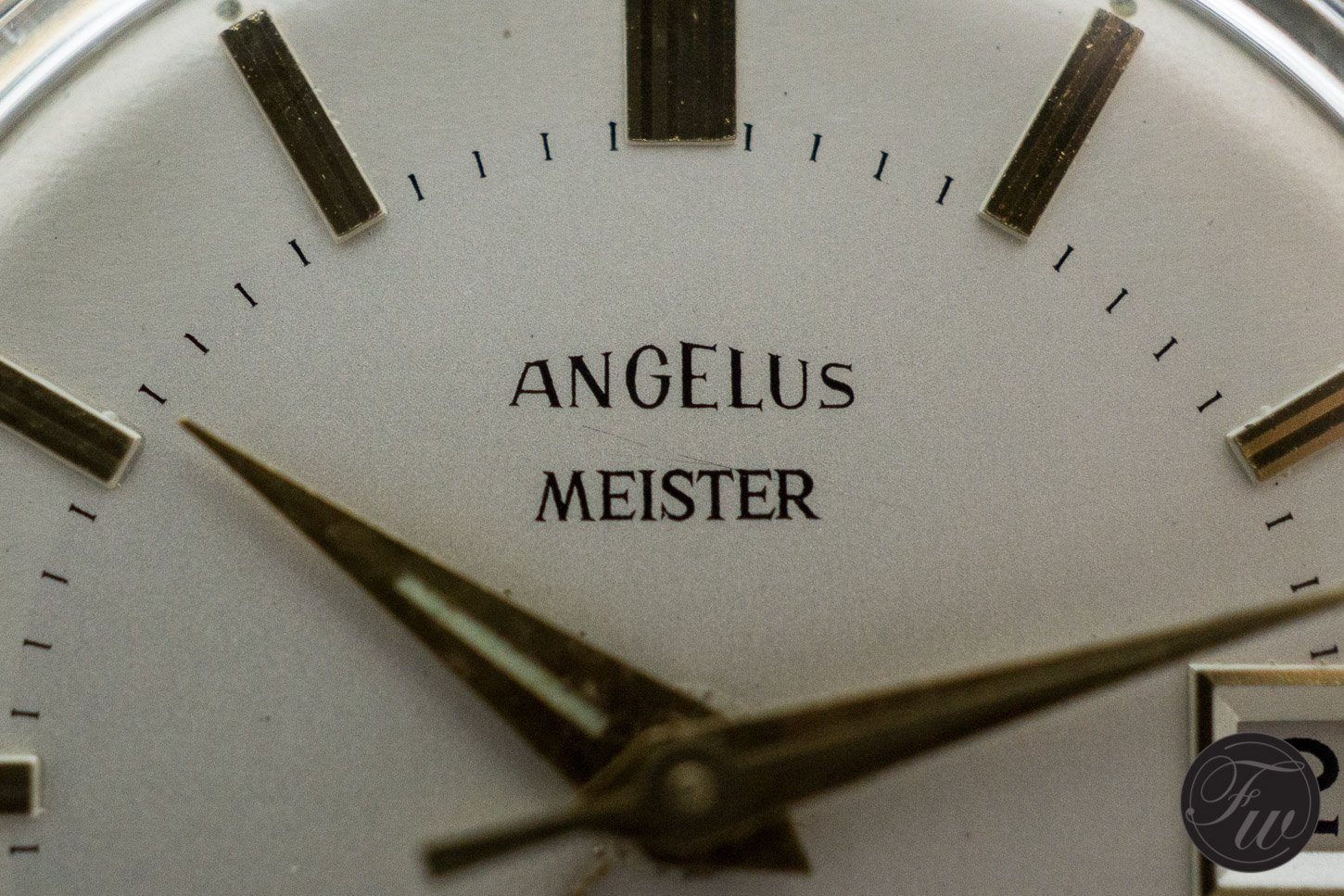
Even though the main dial color was white it had 2 shades. Sometimes the outer ring – same thickness as the indexes – was lighter and the inner dial was darker. Or the other way around, darker outer ring and lighter inner dial. The border was always the painted second’s scale. The hands earlier were dauphine-shape, on later models, like mine, they became flat and had lume lines on them. You can also find lume dots on the outer sides of the indexes. One interesting feature that my watch has is the Meister under Angelus on the dial. Now, seeing a Meister dial is not necessarily uncommon but a), it adds a bit of coolness to the watch (in my book, anyway) and b), it is rather unusual when it comes to Angelus Datalarm. I have yet to see another one during my research.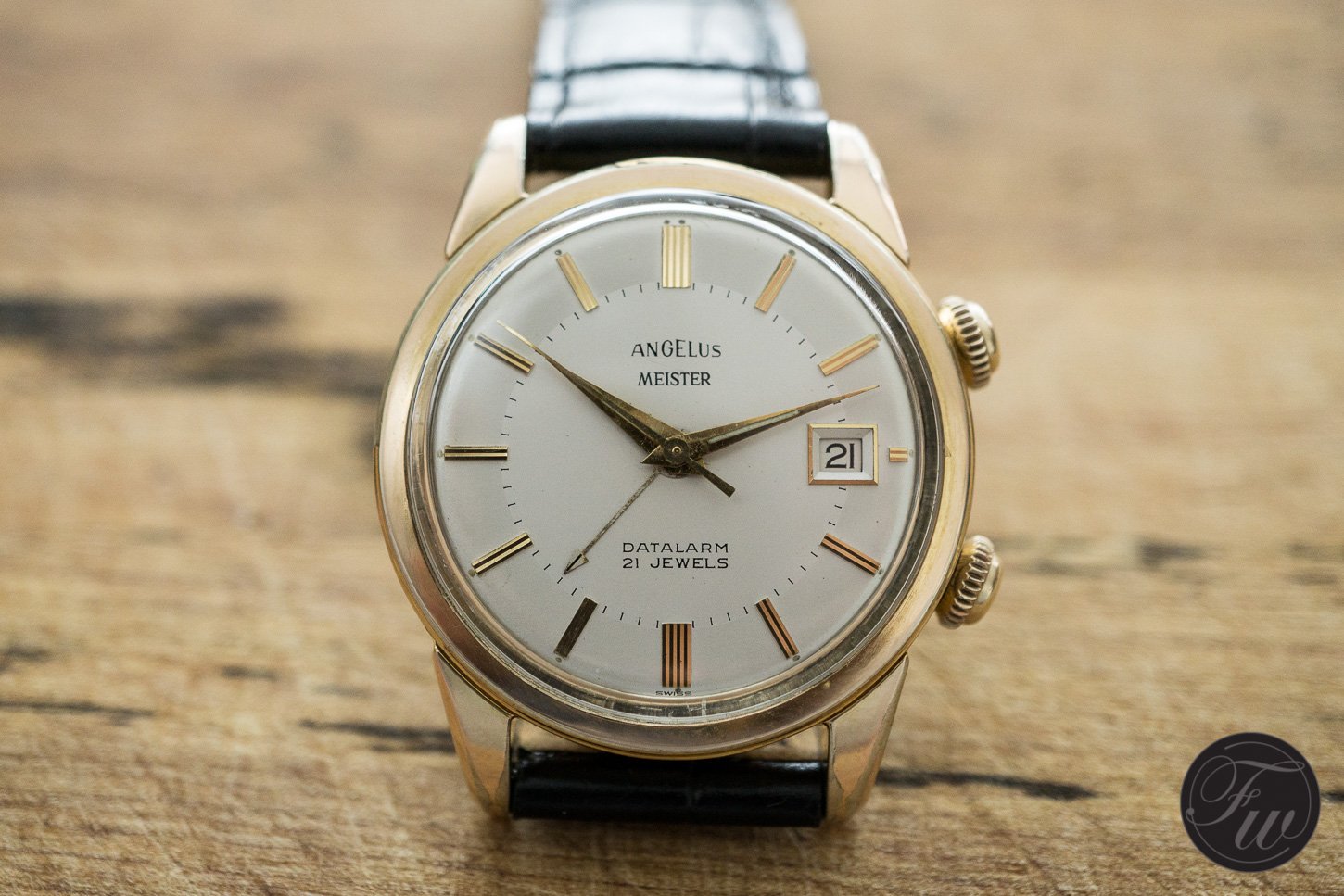
Worth knowing
About 10 years after the initial release in 1967 Angelus produced the rarest version of the Datalarm. That one had a world time dial and a black 24-hour bezel. Those had the same cases but, due to the bezel, looked and wore a bit larger than the earlier versions. There are 2 dial versions; the Paris and the Stockholm dials. They got their names after the city above the 12 o’clock index. Stockholm is instantly recognizable since on those the name of the city is in red. But only Stockholm, the other city names remained black. The pocket watch version of the Datalarm came to the market in 1960. You can still find them relatively cheap (€400-600) but make sure you look for a fully working example. The Angelus Datalarm is a fun and useful timepiece, not a one trick pony. It’s the perfect conversation starter too.
If you are an Angelus fan make sure you download this Angelus Collector’s Guide.

